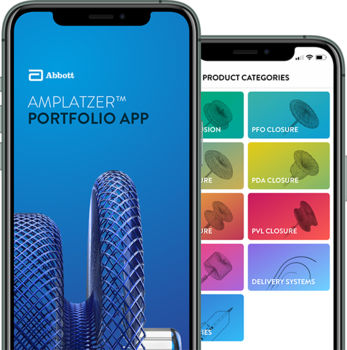VENTRICULAR SEPTAL
DEFECT OCCLUDERS
STRUCTURAL INTERVENTIONS
Ventricular septal defects (VSDs) are the most commonly found congenital
heart defect.2 Our Amplatzer™ VSD portfolio includes occluders specifically
designed to close complex VSDs in patients considered to be too high risk for
standard surgical repair.
THE PIONEER IN VENTRICULAR SEPTAL OCCLUDERS1
Abbott’s Amplatzer line not only pioneered structural heart defect occluders, it also retains a leadership position in structural heart innovation and treatment worldwide.1 Amplatzer™ VSD Occluders have a record of safety and effectiveness for more than 20 years.
A ventricular septal defect (VSD) is a hole in the septum between the ventricles and is the most common type of heart malformation.2 A VSD allows blood from the left ventricle to pass through into the right ventricle, creating extra stress to the right ventricle in order to keep up with the additional blood flow. Patients with a VSD carry an increased risk of infection to the heart walls and valves.
Types of VSD
There are 4 types of VSDs:
- Perimembranous
- Muscular
- Conal, or subpulmonary
- Inlet
Amplatzer options for Ventricular Septal Defect closure
Abbott offers two devices for transcatheter VSD closure, the Amplatzer Muscular VSD Occluder and the Amplatzer Post-MI Muscular VSD Occluder. Like many Amplatzer occluders, these devices:
- Are self-expandable, double-disc devices
- Are made of nitinol wire mesh with interwoven polyester substrate to promote occlusion and tissue in-growth
- Can be recaptured and redeployed if necessary for precise placement
- Are designed for complete closure
- Have a symmetrical design that allows for a venous or arterial delivery approach
- Have a connecting waist that corresponds to the size of the VSD*
TV
- Data on file at Abbott.
- Stout KK, Daniels CJ, Aboulhosn JA, et al. 2018 AHA/ACC Guideline for the Management of Adults with Congenital Heart Disease: a report of the American College of Cardiology/American Heart Association Task Force on Clinical Practice Guidelines. Circulation. 2019;73(12):e81-e192. doi: 10.1161/CIR.0000000000000603.
- Minette MS, Sahn DJ. Ventricular septal defects. Circulation. 2006;114:2190-2197.
- Schlotter F, de Waha S, Eitel I, et al. Interventional post-myocardial infarction ventricular septal defect closure: a systematic review of current evidence. EuroIntervention. 2016;12:94-102.
- Crenshaw BS, Granger CB , Birnbaum Y, et al. Risk factors, angiographic patterns, and outcomes in patients with ventricular septal defect complicating acute myocardial infarction. Circulation. 2000;101(1):27-32.
- Amplatzer Post-infarct Muscular VSD Occluder Instructions for Use.


